
Am Fam Physician. 2020;102(11):673-678
Related letter: Platelet-Rich Plasma Effective for Patients with Knee Osteoarthritis
Published online October 30, 2020.
Author disclosure: Dr. Grad has no relevant financial affiliations. Dr. Ebell is cofounder and editor-in-chief of Essential Evidence Plus; see Editor's Note.
In this article, we discuss the POEMs (patient-oriented evidence that matters) of 2019 judged to be most consistent with the principles of Choosing Wisely, an international campaign to reduce unnecessary testing and treatments. We selected these POEMs through a crowdsourcing strategy of the daily POEMs information service for the Canadian Medical Association's physician members. We present recommendations from these top POEMs of primary research or meta-analysis that identify interventions to encourage or consider avoiding in practice. The recommendations cover musculoskeletal conditions (e.g., do not recommend platelet-rich plasma injections for rotator cuff disease or knee osteoarthritis), respiratory disease (e.g., in clinically stable patients with community-acquired pneumonia, antibiotics can be stopped after five days), screening or preventive care (e.g., patients who take their blood pressure at home or in a pharmacy should know what to do when they have an elevated reading), and miscellaneous topics (e.g., in healthy adults treated for dermatophyte infection, do not obtain baseline or follow-up alanine transaminase level, aspartate transaminase level, or complete blood count). These POEMs describe interventions whose benefits are not superior to other options, are sometimes more expensive, or put patients at increased risk of harm. Knowing more about these POEMs and their connection with the Choosing Wisely campaign will help clinicians and patients engage in conversations better informed by high-quality evidence.
The coronavirus disease 2019 (COVID-19) pandemic has left its mark. Perhaps more than ever, we understand the importance of implementing the principles of the Choosing Wisely campaign in clinical practice to improve resource stewardship. Since 2016, articles in this series have highlighted POEMs (patient-oriented evidence that matters) as sparks to change practice, in line with the principles of the Choosing Wisely campaign.1 POEMs are synopses of research studies that report patient-oriented outcomes, such as improvement in symptoms, quality of life, or mortality. They describe studies that are free of important methodologic bias and recommend a change in practice for many physicians. In this article, we discuss the daily POEMs of 2019 that were judged to be most consistent with principles of the Choosing Wisely campaign, an international effort to reduce unnecessary medical tests, treatments, and procedures. Rather than having experts select the top POEMs, we use a crowd-sourcing method to identify new studies about clinical actions most consistent with Choosing Wisely, from the perspective of the physician in everyday practice.2
In brief, our crowdsourcing method to identify the top POEMs consistent with the Choosing Wisely campaign is based on ratings of the daily POEM delivered to physicians in a CME program. In 2019, we received an average of 1,530 physician ratings for each of the 254 POEMs delivered to members of the Canadian Medical Association. As identified by these physicians, we present the top POEMs of 2019 whose findings can help to reduce overdiagnosis or overtreatment in clinical practice.
Eleven of the top research studies of 2019 also ranked near the top for Choosing Wisely.3 Because these POEMs were summarized earlier this year in a related article, we do not rediscuss them here. However, to highlight their importance, POEMs on these studies are summarized in eTable A. In addition, all articles in the top POEMs series are available at https://www.aafp.org/afp/toppoems.
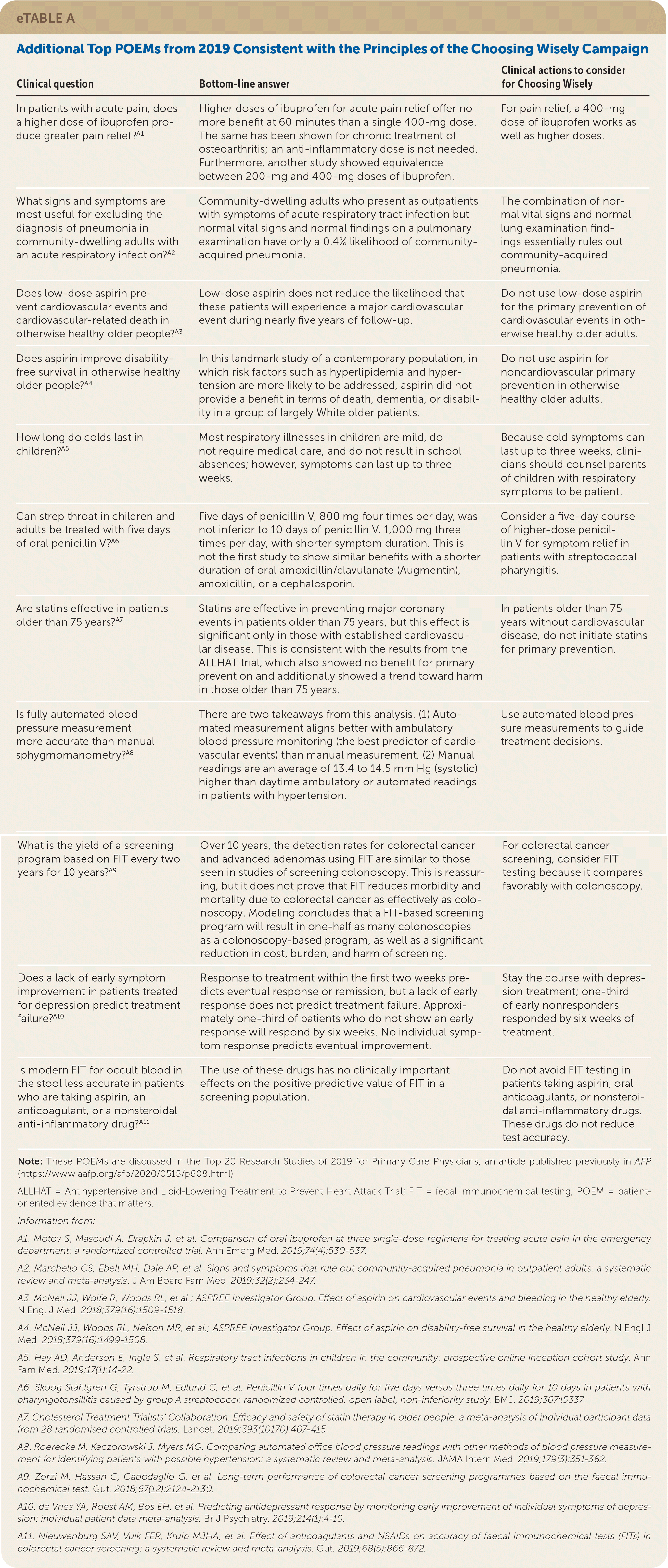
| Clinical question | Bottom-line answer | Clinical actions to consider for Choosing Wisely |
|---|---|---|
| In patients with acute pain, does a higher dose of ibuprofen produce greater pain relief?A1 | Higher doses of ibuprofen for acute pain relief offer no more benefit at 60 minutes than a single 400-mg dose. The same has been shown for chronic treatment of osteoarthritis; an anti-inflammatory dose is not needed. Furthermore, another study showed equivalence between 200-mg and 400-mg doses of ibuprofen. | For pain relief, a 400-mg dose of ibuprofen works as well as higher doses. |
| What signs and symptoms are most useful for excluding the diagnosis of pneumonia in community-dwelling adults with an acute respiratory infection?A2 | Community-dwelling adults who present as outpatients with symptoms of acute respiratory tract infection but normal vital signs and normal findings on a pulmonary examination have only a 0.4% likelihood of community-acquired pneumonia. | The combination of normal vital signs and normal lung examination findings essentially rules out community-acquired pneumonia. |
| Does low-dose aspirin prevent cardiovascular events and cardiovascular-related death in otherwise healthy older people?A3 | Low-dose aspirin does not reduce the likelihood that these patients will experience a major cardiovascular event during nearly five years of follow-up. | Do not use low-dose aspirin for the primary prevention of cardiovascular events in otherwise healthy older adults. |
| Does aspirin improve disability-free survival in otherwise healthy older people?A4 | In this landmark study of a contemporary population, in which risk factors such as hyperlipidemia and hypertension are more likely to be addressed, aspirin did not provide a benefit in terms of death, dementia, or disability in a group of largely White older patients. | Do not use aspirin for noncardiovascular primary prevention in otherwise healthy older adults. |
| How long do colds last in children?A5 | Most respiratory illnesses in children are mild, do not require medical care, and do not result in school absences; however, symptoms can last up to three weeks. | Because cold symptoms can last up to three weeks, clinicians should counsel parents of children with respiratory symptoms to be patient. |
| Can strep throat in children and adults be treated with five days of oral penicillin V?A6 | Five days of penicillin V, 800 mg four times per day, was not inferior to 10 days of penicillin V, 1,000 mg three times per day, with shorter symptom duration. This is not the first study to show similar benefits with a shorter duration of oral amoxicillin/clavulanate (Augmentin), amoxicillin, or a cephalosporin. | Consider a five-day course of higher-dose penicillin V for symptom relief in patients with streptococcal pharyngitis. |
| Are statins effective in patients older than 75 years?A7 | Statins are effective in preventing major coronary events in patients older than 75 years, but this effect is significant only in those with established cardiovascular disease. This is consistent with the results from the ALLHAT trial, which also showed no benefit for primary prevention and additionally showed a trend toward harm in those older than 75 years. | In patients older than 75 years without cardiovascular disease, do not initiate statins for primary prevention. |
| Is fully automated blood pressure measurement more accurate than manual sphygmomanometry?A8 | There are two takeaways from this analysis. (1) Automated measurement aligns better with ambulatory blood pressure monitoring (the best predictor of cardiovascular events) than manual measurement. (2) Manual readings are an average of 13.4 to 14.5 mm Hg (systolic) higher than daytime ambulatory or automated readings in patients with hypertension. | Use automated blood pressure measurements to guide treatment decisions. |
| What is the yield of a screening program based on FIT every two years for 10 years?A9 | Over 10 years, the detection rates for colorectal cancer and advanced adenomas using FIT are similar to those seen in studies of screening colonoscopy. This is reassuring, but it does not prove that FIT reduces morbidity and mortality due to colorectal cancer as effectively as colonoscopy. Modeling concludes that a FIT-based screening program will result in one-half as many colonoscopies as a colonoscopy-based program, as well as a significant reduction in cost, burden, and harm of screening. | For colorectal cancer screening, consider FIT testing because it compares favorably with colonoscopy. |
| Does a lack of early symptom improvement in patients treated for depression predict treatment failure?A10 | Response to treatment within the first two weeks predicts eventual response or remission, but a lack of early response does not predict treatment failure. Approximately one-third of patients who do not show an early response will respond by six weeks. No individual symptom response predicts eventual improvement. | Stay the course with depression treatment; one-third of early nonresponders responded by six weeks of treatment. |
| Is modern FIT for occult blood in the stool less accurate in patients who are taking aspirin, an anticoagulant, or a nonsteroidal anti-inflammatory drug?A11 | The use of these drugs has no clinically important effects on the positive predictive value of FIT in a screening population. | Do not avoid FIT testing in patients taking aspirin, oral anticoagulants, or nonsteroidal anti-inflammatory drugs. These drugs do not reduce test accuracy. |
Musculoskeletal Conditions
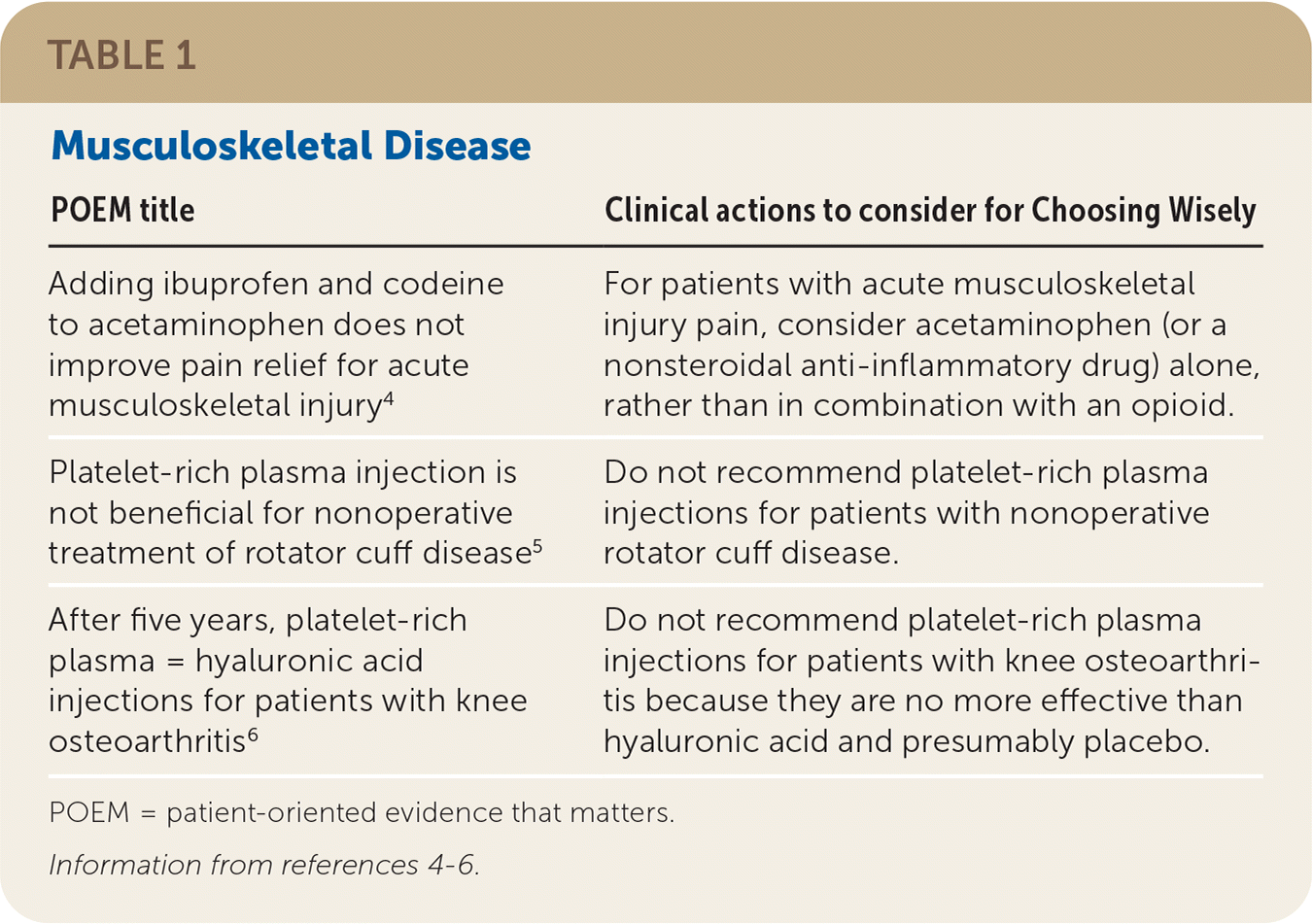
| POEM title | Clinical actions to consider for Choosing Wisely |
|---|---|
| Adding ibuprofen and codeine to acetaminophen does not improve pain relief for acute musculoskeletal injury4 | For patients with acute musculoskeletal injury pain, consider acetaminophen (or a nonsteroidal anti-inflammatory drug) alone, rather than in combination with an opioid. |
| Platelet-rich plasma injection is not beneficial for nonoperative treatment of rotator cuff disease5 | Do not recommend platelet-rich plasma injections for patients with nonoperative rotator cuff disease. |
| After five years, platelet-rich plasma = hyaluronic acid injections for patients with knee osteoarthritis6 | Do not recommend platelet-rich plasma injections for patients with knee osteoarthritis because they are no more effective than hyaluronic acid and presumably placebo. |
ACUTE MUSCULOSKELETAL INJURY PAIN
The first study included 119 patients presenting to an emergency department with acute musculoskeletal injury. Patients were randomized to receive 1,000 mg of acetaminophen plus placebo or 1,000 mg of acetaminophen plus 400 mg of ibuprofen plus 60 mg of codeine.4 Pain at rest was reduced similarly in both groups at one and two hours. Pain with activity was reduced slightly more with the combination therapy, but this difference was not considered clinically important, and adverse events were three times more common in the combination therapy group.
PLATELET-RICH PLASMA INJECTIONS
The next two studies evaluated the effectiveness of platelet-rich plasma injections. The first was a meta-analysis of five studies evaluating this therapy in a total of 214 patients with chronic rotator cuff disease.5 The control groups received a variety of interventions, such as saline or corticosteroid injection, dry needling, or exercise therapy. At six to 12 months of follow-up, there was no difference between the intervention group and the control groups in pain, disability, or range of motion. In the studies comparing platelet-rich plasma injections with exercise, the exercise group had better outcomes.
The second POEM was the five-year follow-up of a study that randomized 192 patients with severe knee osteoarthritis to receive injections of platelet-rich plasma or hyaluronic acid.6 Because previous systematic reviews of adequately controlled and masked trials of hyaluronic acid found no significant benefit vs. placebo,7,8 this POEM could be considered similar to a placebo-controlled trial. After five years, about 86% of patients remained in the study, and pain and functional scores were similar between groups. Therefore, neither platelet-rich plasma nor hyaluronic acid is recommended over placebo for the treatment of knee osteoarthritis.
Respiratory Disease
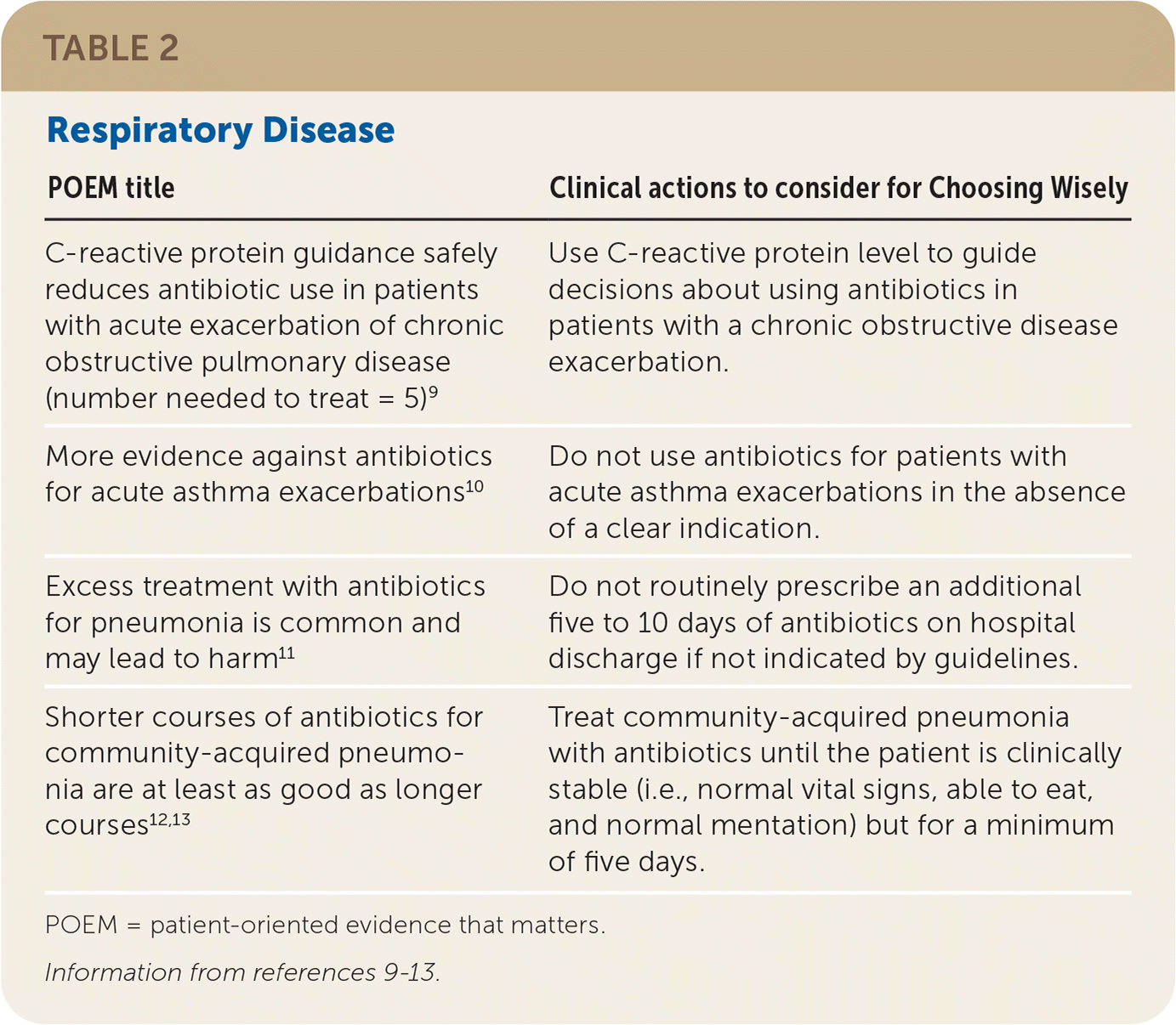
| POEM title | Clinical actions to consider for Choosing Wisely |
|---|---|
| C-reactive protein guidance safely reduces antibiotic use in patients with acute exacerbation of chronic obstructive pulmonary disease (number needed to treat = 5)9 | Use C-reactive protein level to guide decisions about using antibiotics in patients with a chronic obstructive disease exacerbation. |
| More evidence against antibiotics for acute asthma exacerbations10 | Do not use antibiotics for patients with acute asthma exacerbations in the absence of a clear indication. |
| Excess treatment with antibiotics for pneumonia is common and may lead to harm11 | Do not routinely prescribe an additional five to 10 days of antibiotics on hospital discharge if not indicated by guidelines. |
| Shorter courses of antibiotics for community-acquired pneumonia are at least as good as longer courses12,13 | Treat community-acquired pneumonia with antibiotics until the patient is clinically stable (i.e., normal vital signs, able to eat, and normal mentation) but for a minimum of five days. |
CHRONIC LUNG DISEASE
Two POEMs address the use of antibiotics in patients with chronic lung disease. The first study randomized 653 patients with a chronic obstructive pulmonary disease exacerbation to usual care or to care guided by results of a point-of-care C-reactive protein (CRP) test.9 Clinicians were advised to use no antibiotics for a CRP level of less than 2 mg per dL (20 mg per L), to consider antibiotics for a level between 2 and 4 mg per dL (20 and 40 mg per L), and that they are likely to be beneficial for a level greater than 4 mg per dL (40 mg per L). Those in the CRP-guided group were less likely to receive antibiotics (57% vs. 77%; number needed to treat = 5), had more symptom improvement at two weeks, and experienced no difference in adverse outcomes.
The second study was an observational study of patients hospitalized with asthma.10 This study compared the 44% of patients who received antibiotics on admission with a propensity score–matched cohort of 13,666 patients who did not receive antibiotics. Early antibiotics were associated with higher cost, longer length of hospitalization, and higher likelihood of diarrhea, but no difference in the risk of treatment failure or 30-day mortality.
COMMUNITY-ACQUIRED PNEUMONIA
The next two POEMs address the problem of prescribing too many days of antibiotics for community-acquired pneumonia. Current guidelines recommend that patients with community-acquired pneumonia receive an antibiotic for at least five days; antibiotics may be discontinued after five days if the patient is clinically stable (i.e., normal vital signs, ability to eat, and normal mentation).11 Too often, antibiotic treatment duration is based on conventional practice (seven to 10 days), rather than on the best available evidence.
The first POEM was an observational study of 6,481 patients with community-acquired pneumonia or hospital-acquired pneumonia in 43 Michigan hospitals.12 The study found more than 2,500 excess days of antibiotic treatment per 1,000 patients. Antibiotics prescribed at discharge for an additional five to 10 days accounted for 93% of the excess days.
The second POEM was a systematic review of 19 randomized and two nonrandomized studies comparing a shorter course (six days or less) with a longer course (more than six days) of antibiotics for patients with community-acquired pneumonia.13 Whether studies were comparing the same or different antibiotics, the outcomes were the same: shorter courses discontinued after clinical improvement are equally effective for cure as longer courses, with no difference in relapse rates and fewer adverse events.
Screening or Preventive Care
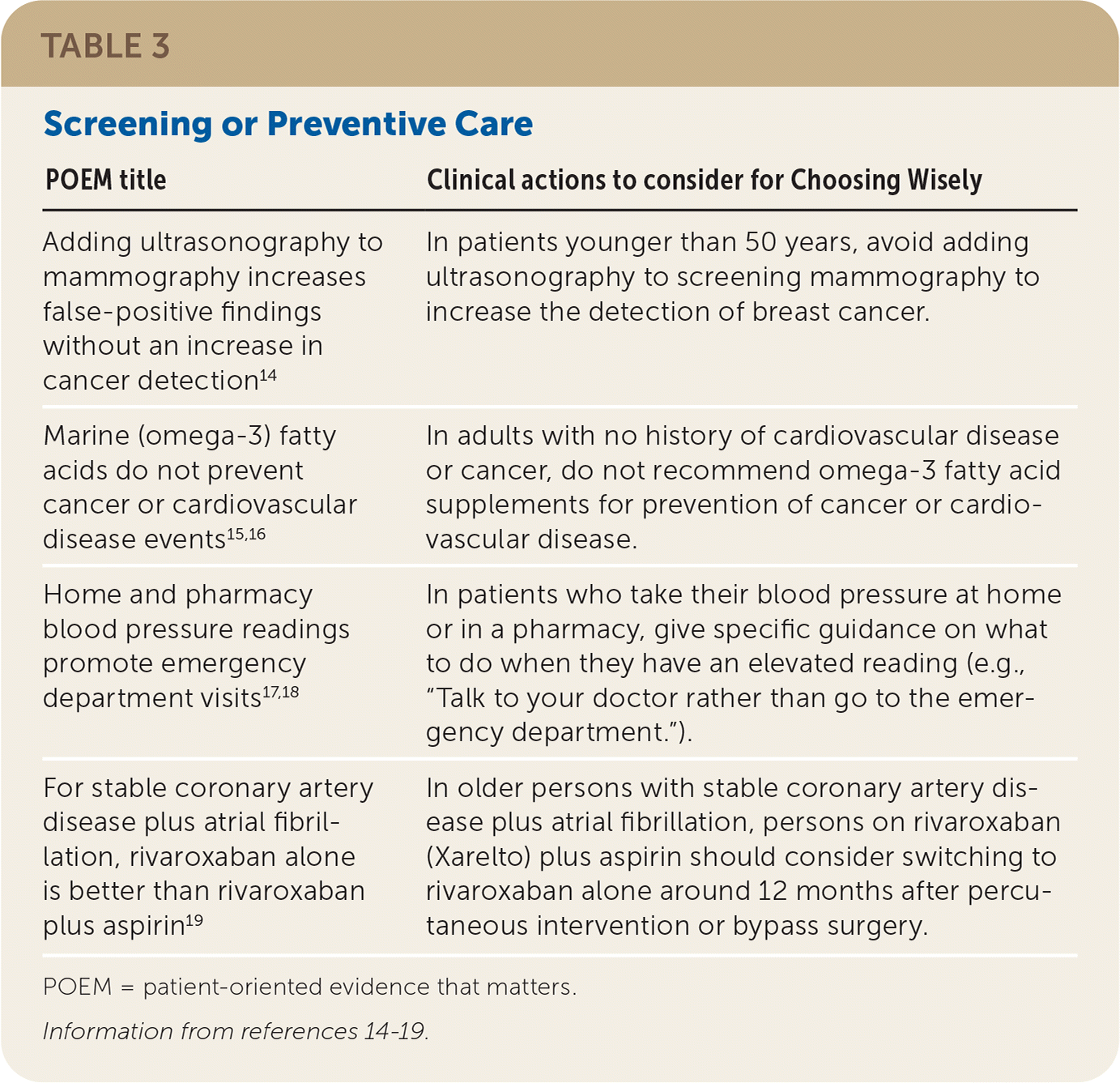
| POEM title | Clinical actions to consider for Choosing Wisely |
|---|---|
| Adding ultrasonography to mammography increases false-positive findings without an increase in cancer detection14 | In patients younger than 50 years, avoid adding ultrasonography to screening mammography to increase the detection of breast cancer. |
| Marine (omega-3) fatty acids do not prevent cancer or cardiovascular disease events15,16 | In adults with no history of cardiovascular disease or cancer, do not recommend omega-3 fatty acid supplements for prevention of cancer or cardiovascular disease. |
| Home and pharmacy blood pressure readings promote emergency department visits17,18 | In patients who take their blood pressure at home or in a pharmacy, give specific guidance on what to do when they have an elevated reading (e.g., “Talk to your doctor rather than go to the emergency department.”). |
| For stable coronary artery disease plus atrial fibrillation, rivaroxaban alone is better than rivaroxaban plus aspirin19 | In older persons with stable coronary artery disease plus atrial fibrillation, persons on rivaroxaban (Xarelto) plus aspirin should consider switching to rivaroxaban alone around 12 months after percutaneous intervention or bypass surgery. |
BREAST CANCER SCREENING
The first POEM in this group is a cohort study evaluating the addition of ultrasonography to screening mammography in patients younger than 50 years.14 Most (74%) of the 6,000 ultrasound screenings in this study were performed in patients with dense breasts. Adding ultrasonography to screening mammography for those at low, intermediate, or high risk of breast cancer was not associated with an increase in breast cancer detection. It was, however, associated with increased unnecessary biopsy recommendations and more frequent follow-up.
OMEGA-3 FATTY ACID SUPPLEMENTS
The next POEM reported on the results of the first adequately powered U.S. trial comparing omega-3 fatty acids with placebo for the primary prevention of cardiovascular disease or cancer.15 This trial enrolled nearly 26,000 patients older than 50 years with no history of cardiovascular disease or cancer. Groups were balanced at the start of the study; the mean age was 67 years, 51% were women, and 14% had diabetes mellitus. After a median follow-up of 5.3 years, omega-3 fatty acid use was not associated with a reduction in the likelihood of cancer or in the composite cardiovascular outcome (cardiovascular death, nonfatal myocardial infarction, or ischemic stroke). In 2019, another POEM reported on the ASCEND (A Study of Cardiovascular Events in Diabetes) trial of the use of omega-3 fatty acids in 15,000 patients with diabetes. The same null effect was observed.16
OUT-OF-OFFICE BLOOD PRESSURE MEASUREMENT
This POEM is an example of an unintended consequence of engaging patients in blood pressure monitoring. To avoid the overdiagnosis of hypertension in people with white coat syndrome, guidelines recommend home blood pressure monitoring.17 An observational study of five hospitals in the province of Ontario, Canada, reported that home or pharmacy blood pressure monitoring prompted one-half of all emergency department visits for high blood pressure.18 Many of these patients had nonspecific symptoms.
With recommendations for more at-home or other non–office-based monitoring, patients need specific guidance on what to do with their readings, including the specific symptoms that require emergent care. Most elevated blood pressure levels can be managed with the advice and care of a primary care physician, avoiding unnecessary visits to the emergency department.
ATRIAL FIBRILLATION AND CORONARY ARTERY DISEASE
The last POEM in this group asked the following question: Is rivaroxaban (Xarelto) plus an antiplatelet agent superior to rivaroxaban alone for atrial fibrillation and coronary artery disease? The answer is no. On the contrary, in older patients (mean age of 74 years) taking rivaroxaban monotherapy, there are fewer deaths (1.85% vs. 3.37%; P < .05; number needed to treat = 66 per year), hemorrhagic strokes, and major bleeding events. The evidence for this comes from a large randomized trial, terminated after a median follow-up of 23 months, including older adults with atrial fibrillation.19 All patients in the study had undergone a percutaneous intervention or bypass surgery at least 12 months before the study. Thus, for stable coronary artery disease and atrial fibrillation, rivaroxaban alone is better than rivaroxaban plus aspirin.
Miscellaneous
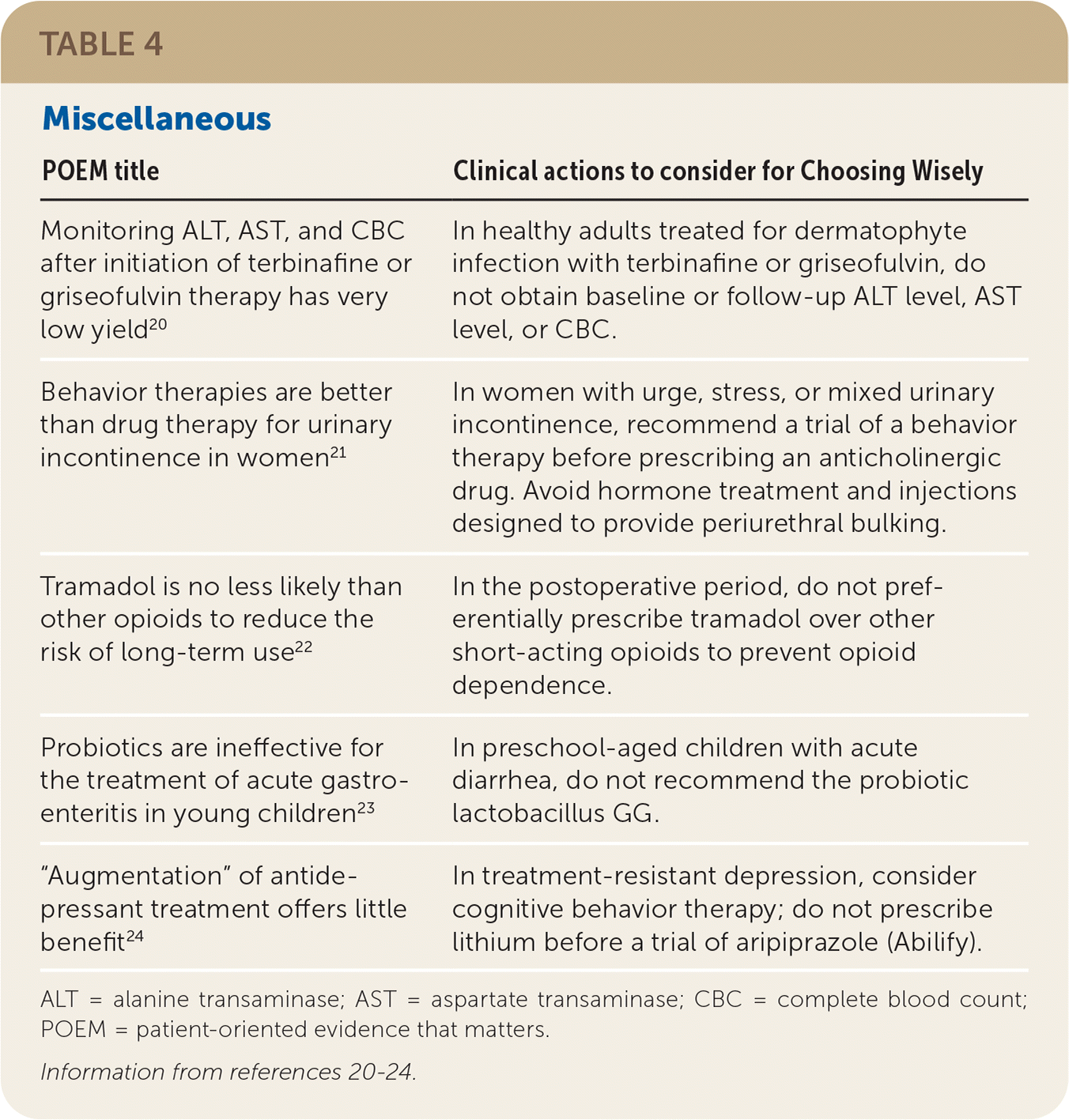
| POEM title | Clinical actions to consider for Choosing Wisely |
|---|---|
| Monitoring ALT, AST, and CBC after initiation of terbinafine or griseofulvin therapy has very low yield20 | In healthy adults treated for dermatophyte infection with terbinafine or griseofulvin, do not obtain baseline or follow-up ALT level, AST level, or CBC. |
| Behavior therapies are better than drug therapy for urinary incontinence in women21 | In women with urge, stress, or mixed urinary incontinence, recommend a trial of a behavior therapy before prescribing an anticholinergic drug. Avoid hormone treatment and injections designed to provide periurethral bulking. |
| Tramadol is no less likely than other opioids to reduce the risk of long-term use22 | In the postoperative period, do not preferentially prescribe tramadol over other short-acting opioids to prevent opioid dependence. |
| Probiotics are ineffective for the treatment of acute gastroenteritis in young children23 | In preschool-aged children with acute diarrhea, do not recommend the probiotic lactobacillus GG. |
| “Augmentation” of antidepressant treatment offers little benefit24 | In treatment-resistant depression, consider cognitive behavior therapy; do not prescribe lithium before a trial of aripiprazole (Abilify). |
LABORATORY TESTING DURING ORAL ANTIFUNGAL THERAPY
It would seem reasonable to check for preexisting laboratory abnormalities before initiation of terbinafine or griseofulvin for dermatophyte infection and to perform follow-up testing after initiation of treatment to monitor for hepatotoxicity. Yet, a cohort study of about 5,000 adults and children showed that neither baseline testing nor follow-up testing is helpful.20 In the POEM, less than 0.2% of the study cohort developed liver enzyme elevation three times the upper limit of normal during treatment.
URINARY INCONTINENCE IN WOMEN
The next POEM was a network meta-analysis of treatments for urge, stress, or mixed urinary incontinence in women.21 All interventions examined were effective, except estrogen and injections to provide periurethral bulking. Although it is easier to prescribe a trial of an anticholinergic medication, an attempt at behavior therapy in a motivated patient is an appropriate initial intervention.
OPIOIDS FOR ACUTE POSTOPERATIVE PAIN
Despite efforts to limit narcotic prescribing, long-term opioid use remains common in patients with chronic pain. In a cohort study comparing the length of tramadol use with other opioids, such as hydrocodone and oxycodone, in 444,000 patients who had undergone surgery, 7% of all patients received an additional opioid prescription 90 to 180 days after surgery.22 There were no meaningful differences among opioids in length of use. Thus, tramadol is no less likely than other opioids to result in long-term use and should not be favored over other short-acting opioids in the short term.
PROBIOTICS FOR ACUTE GASTROENTERITIS IN CHILDREN
The next POEM showed that the probiotic lactobacillus GG is ineffective in the treatment of acute gastroenteritis in young children (median age of 1.4 years).23 This was a randomized placebo-controlled trial of almost 1,000 patients with diarrhea (median duration of 53 hours). The children received the probiotic or placebo once daily for five days. After 14 days, there was no difference in the likelihood of moderate to severe diarrhea, which was the primary outcome. There was also no difference in the duration or frequency of diarrhea.
Whether a different type of industrially grown probiotic would be beneficial is an interesting question. In 2014, a meta-analysis of 22 mostly low-quality studies reported the duration of diarrhea was 19 hours less in children treated with Saccharomyces boulardii.25
TREATMENT-RESISTANT DEPRESSION
The final POEM addresses the question of augmenting antidepressant therapy for treatment-resistant depression (i.e., symptoms are unresponsive to at least two different antidepressants of adequate dose and treatment length). A systematic review of 28 randomized studies addresses this complex and nuanced condition.24 Of the trials, 25 investigated the addition of pharmacotherapy, and three investigated the addition of psychological therapies. Cognitive behavior therapy was more effective than placebo in a single study, but other counseling interventions were not. There was a small likelihood of benefit after short-term treatment with aripiprazole (Abilify; four studies; effect size = 1.33; 95% CI, 1.23 to 1.44) compared with placebo. Lithium was no more effective than placebo (three studies; effect size = 1.00; 95% CI, 0.81 to 1.20).
Editor's Note: This article was cowritten by Dr. Ebell, who is deputy editor for evidence-based medicine for AFP and cofounder and editor-in-chief of Essential Evidence Plus, published by Wiley-Blackwell, Inc. Because of Dr. Ebell's dual roles and ties to Essential Evidence Plus, the article underwent peer review and editing by four of AFP's medical editors. Dr. Ebell was not involved in the editorial decision-making process.—Sumi M. Sexton, MD, Editor-in-Chief
See the Top POEMs from previous years at https://www.aafp.org/afp/toppoems.
